Raymond 'Ray' L. McPherson 1920 -2010
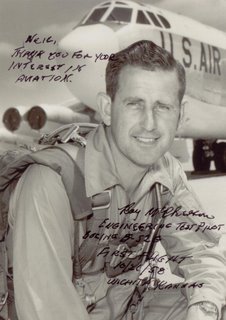
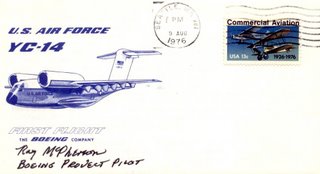
First day cover commemorating the first flight of the Boeing YC-14 from Seattle on August 9th 1976
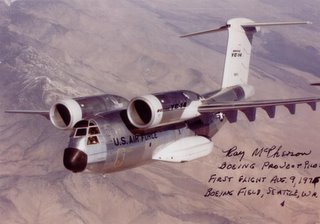 The YC-14 was an experimental aircraft developed between 1971 and 1977 by the Boeing Company and sponsored by the U.S. Air Force. Its basic mission was to carry large, bulky payloads into and out of short, rough dirt fields 2000 ft long, even if an engine failed. Designed to replace the C-130, it had considerably more capability with a large fuselage designed to carry the largest tanks, trucks, and vans in use. The YC-14 configuration had a high wing and large T-tail with the flow from the 50,000 lb thrust turbofan engines exhausted over the top of the wing and passing over the upper surface of the flaps. The flow was turned by the flaps and deflected to augment the aerodynamic lift of the configuration. It was the most efficient powered-lift system ever developed. Ray McPherson performed the maiden flight of the aircraft on August 9th 1976.
The YC-14 was an experimental aircraft developed between 1971 and 1977 by the Boeing Company and sponsored by the U.S. Air Force. Its basic mission was to carry large, bulky payloads into and out of short, rough dirt fields 2000 ft long, even if an engine failed. Designed to replace the C-130, it had considerably more capability with a large fuselage designed to carry the largest tanks, trucks, and vans in use. The YC-14 configuration had a high wing and large T-tail with the flow from the 50,000 lb thrust turbofan engines exhausted over the top of the wing and passing over the upper surface of the flaps. The flow was turned by the flaps and deflected to augment the aerodynamic lift of the configuration. It was the most efficient powered-lift system ever developed. Ray McPherson performed the maiden flight of the aircraft on August 9th 1976. The XB-47D is a high speed, long range composite turbo-prop, turbo-jet bomber whose mission is to serve as a test bed for determining feasilibility of turbo-prop utilization. The normal crew consists of pilot, co-pilot-gunner, and bombardier-navigator.
The XB-47D is a high speed, long range composite turbo-prop, turbo-jet bomber whose mission is to serve as a test bed for determining feasilibility of turbo-prop utilization. The normal crew consists of pilot, co-pilot-gunner, and bombardier-navigator.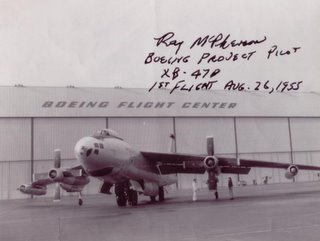 SPECIFICATIONS Span: 116 ft. 0 in. Wing area: 1428 sq. ft.Aspect ratio: 9.43Wing section: Boeing 145Mean Aerodynamic Chord (MAC): 156 in.Length: 106 ft. 8 in. Height: 27 ft. 9 in. Tread: 44 ft. 3 in.Weight: 184,428 lbs. (maximum takeoff weight); 121,850 lbs. (combat weight) Armament: None. The aircraft was delivered as a test bed with no tactical equipment.Engines: Two Wright YT49-W-1 turboprops (axial flow) of 8,500 shaft horsepower each driving Curtiss C-846SA reversible 4-blade 15 ft. diameter propellers and two General Electric J47-GE-23 axial flow turbojets of 5,910 lbs. thrust each at maximum power. Crew: 3 (pilot, copilot-radio operator-gunner, bombardier-navigator)
SPECIFICATIONS Span: 116 ft. 0 in. Wing area: 1428 sq. ft.Aspect ratio: 9.43Wing section: Boeing 145Mean Aerodynamic Chord (MAC): 156 in.Length: 106 ft. 8 in. Height: 27 ft. 9 in. Tread: 44 ft. 3 in.Weight: 184,428 lbs. (maximum takeoff weight); 121,850 lbs. (combat weight) Armament: None. The aircraft was delivered as a test bed with no tactical equipment.Engines: Two Wright YT49-W-1 turboprops (axial flow) of 8,500 shaft horsepower each driving Curtiss C-846SA reversible 4-blade 15 ft. diameter propellers and two General Electric J47-GE-23 axial flow turbojets of 5,910 lbs. thrust each at maximum power. Crew: 3 (pilot, copilot-radio operator-gunner, bombardier-navigator)PERFORMANCE Maximum speed: 519 knots (nautical miles per hour) at 13,500 ft.; 487 knots at 35,000 ft.Combat speed: 461 knotsCruising speed: 402 knots average during cruise-climb profile; initial 24,250 ft. & final 42,400 ft.Combat Radius: 2,717 nautical milesCombat Range: 5,759 nautical miles (ferry mission)Service Ceiling: 33,750 ft. (normal power at maximum take off weight); 42,500 ft. at combat weight (basic mission I) & 48,100 ft. at ferry weight of 90,670 lbs.
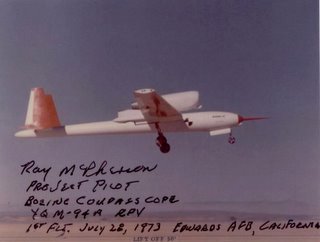 The Boeing Aerospace Co. built the YQM-94A in 1972 for a fly-off competition with the Teledyne-Ryan YQM-96A. designed to meet the same specifications. The first prototype YQM-94A made its initial flight on July 28th 1973, but was destroyed in a crash on August 4, 1973.The YQM-94A is a high-altitude, long-range, remotely piloted vehicle (RPV) designed for long-endurance photographic reconnaissance and electronic surveillance missions. Piloted from the ground, the RPV received guidance signals through a radio link. A television and other electronic equipment aboard Compass Cope sent in-flight data back to the ground-based pilot. Unlike most RPVs, which are ground- or air-launched and retrieved in mid-air, Compass Cope was designed to take off and land from conventional runways.
The Boeing Aerospace Co. built the YQM-94A in 1972 for a fly-off competition with the Teledyne-Ryan YQM-96A. designed to meet the same specifications. The first prototype YQM-94A made its initial flight on July 28th 1973, but was destroyed in a crash on August 4, 1973.The YQM-94A is a high-altitude, long-range, remotely piloted vehicle (RPV) designed for long-endurance photographic reconnaissance and electronic surveillance missions. Piloted from the ground, the RPV received guidance signals through a radio link. A television and other electronic equipment aboard Compass Cope sent in-flight data back to the ground-based pilot. Unlike most RPVs, which are ground- or air-launched and retrieved in mid-air, Compass Cope was designed to take off and land from conventional runways.
Ray McPherson flew some of the most famous Boeing aircraft: the B-47, B-52, the 747 "Flying Command Post," and the unique YC-14 Short Take off and Landing (STOL) expermental airlifter. The design, sponsored by the Air Force under the Advanced Medium STOL Transport program, was meant to replace existing short field transports like the famous C-130 Hercules. It featured an extemely efficient lift system, Upper Surface Blowing (USB), based on the high-mounted engines exhausting over the upper wing, with the airflow then turned downward by the flaps. Eventually, the Air Force stuck with the C-130, but super-experienced fliers like Ray kept pushing the envelope on cutting-edge designs.

<< Home